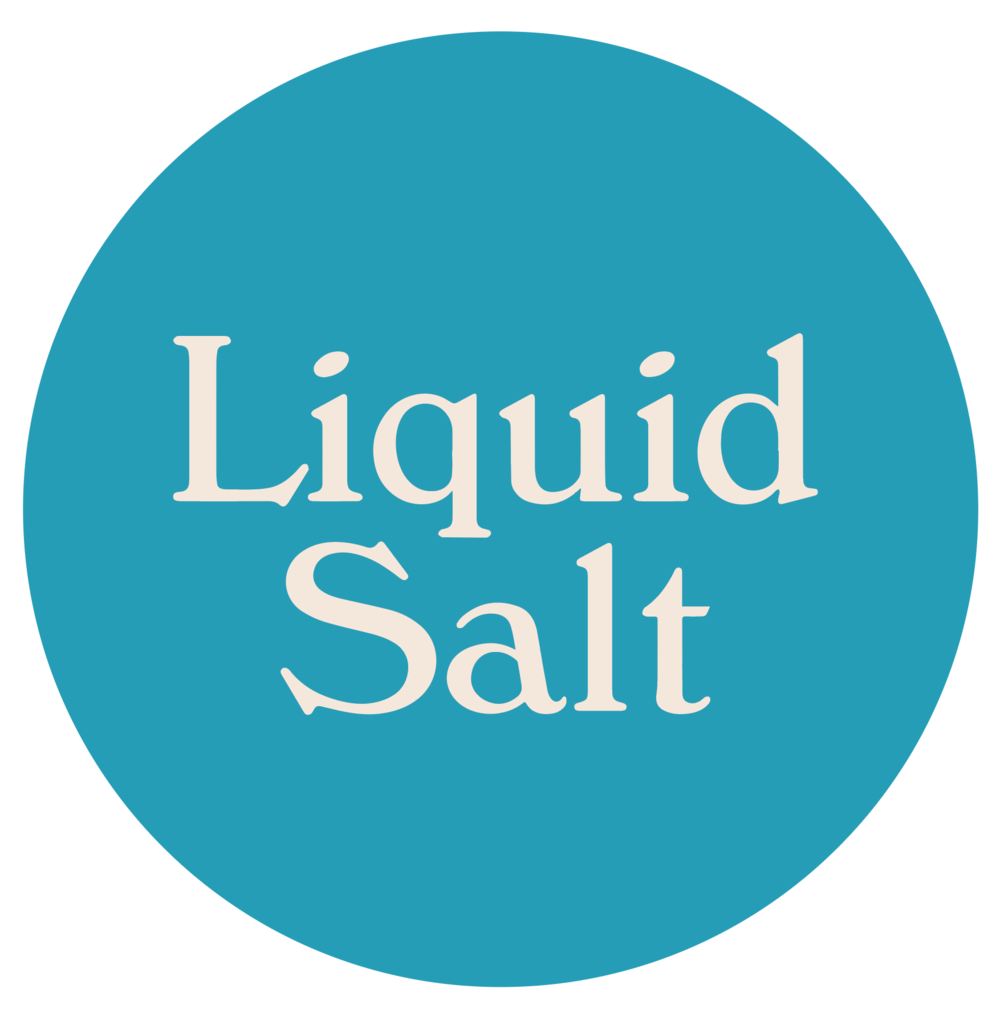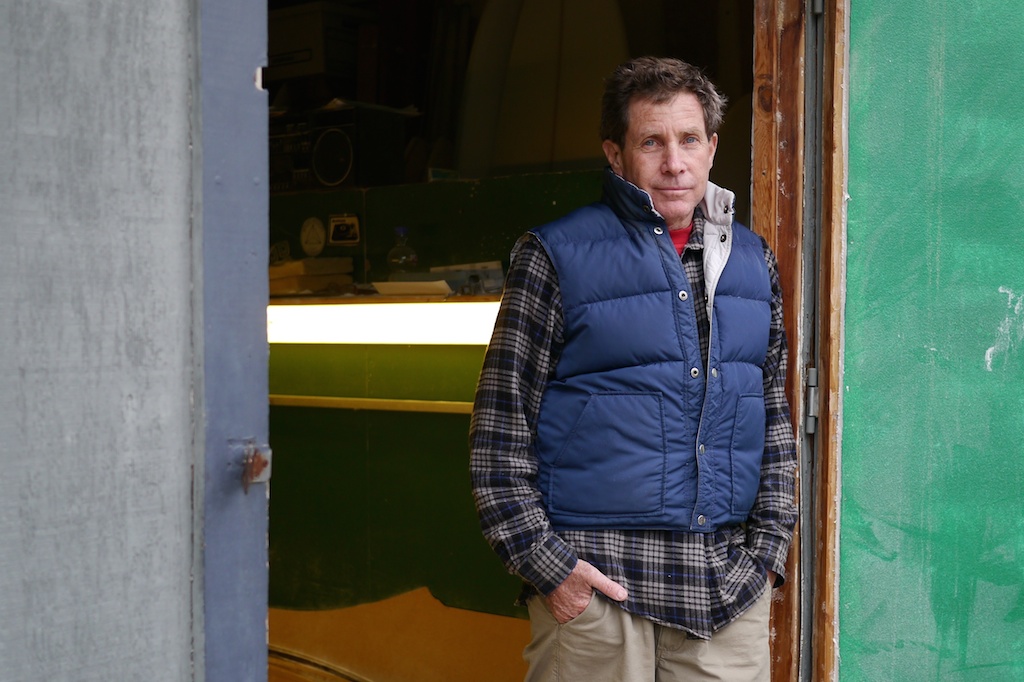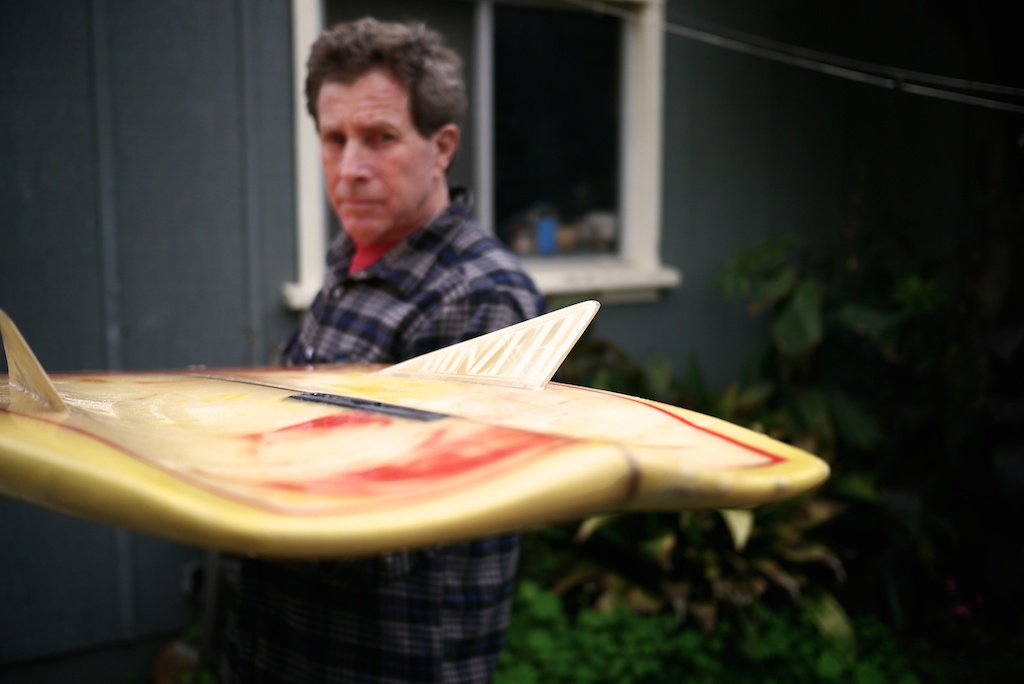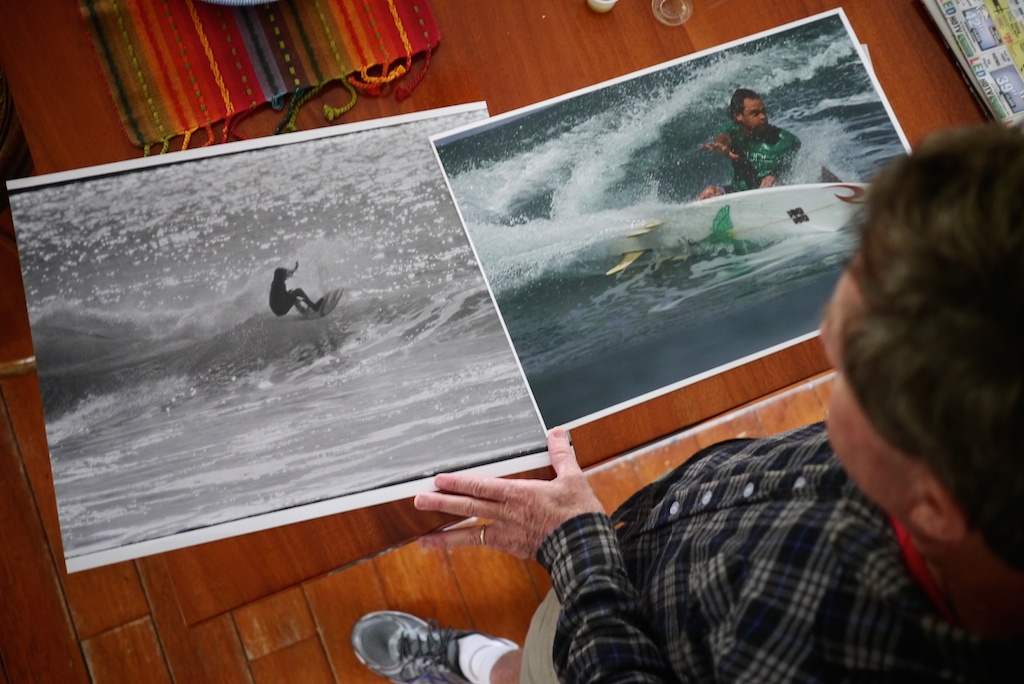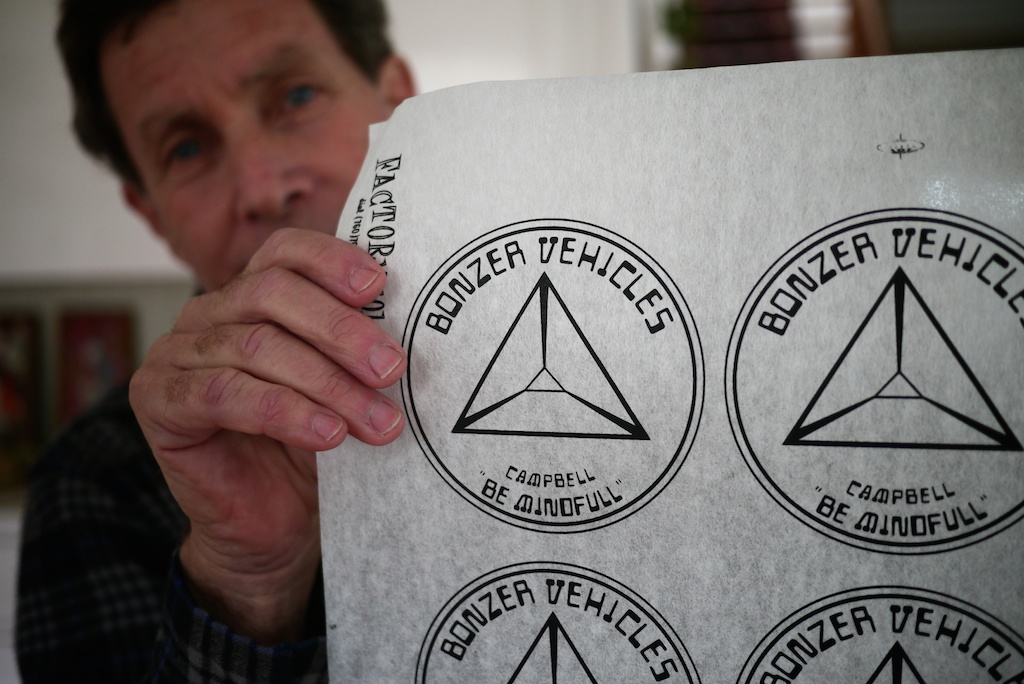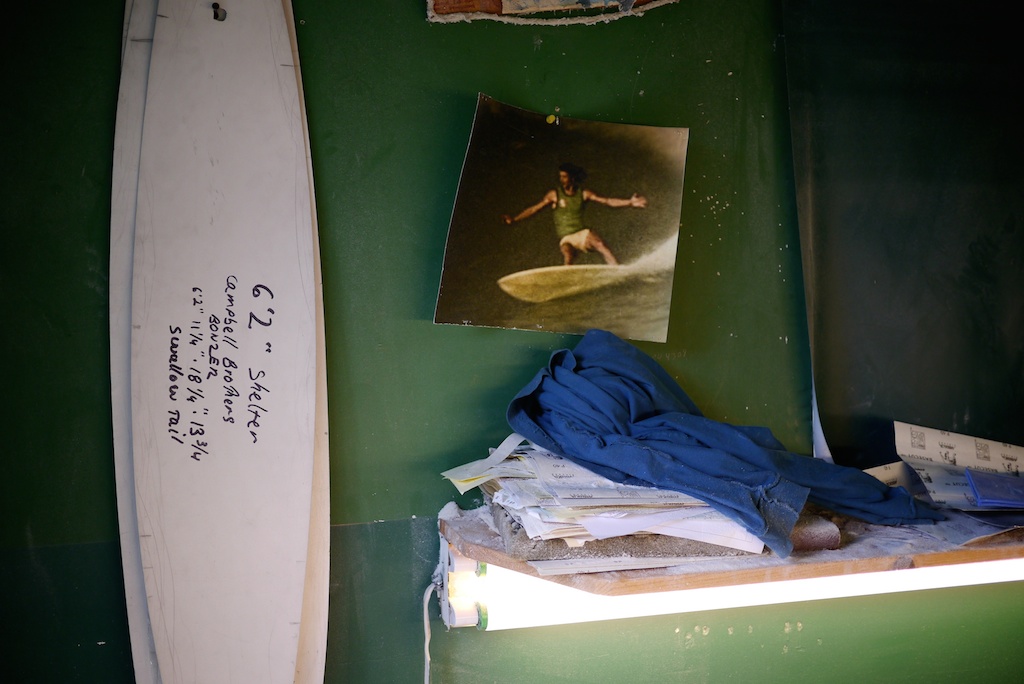Malcolm Campbell
Interview by Glenn Sakamoto
Malcolm Campbell is a legendary shaper/surfer who, together with his brother Duncan, created the first functional three fin surfboard – 10 years before Simon Anderson’s Thruster design. The Campbell Brothers, part of the emerging Shortboard Revolution ignited by the Australians, conspired together in their father’s garage on a futuristic, hydrodynamic system they coined the “Bonzer.” This design would give greater speed and control on a wave than a single or twin finned surfboard. Today, Malcolm believes that the performance potential of the Bonzer has yet to be realized. We spoke with Malcolm to learn more.
What was it like growing up?
Our family lived in the Pacific Palisades and we moved to Oxnard in 1966. I was 14, Duncan was 11, and my sister Ann was 9. My dad was a writer and professional photographer. From the late ‘40s to the mid-’60s he covered sports car races in California and wrote for publications such as Motor Trend and Road & Track. He also worked at the Revell Model Company writing the short histories for the models. My mom was an artist and worked in advertising. She was also very politically active to the point getting roughed up at an anti-war demonstration in Century City when President Lyndon Johnson was in town. My dad was a bodysurfer so we were at the beach a lot as kids. As we got older we started skimboarding, bodysurfing and bellyboarding at Will Rogers State Beach. Duncan started standing up on the bellyboard, but we didn’t really start surfing until we moved up here.
Tell us when you started shaping.
My brother and I shaped our first board in ’68. We stripped the glass off a longboard, reshaped it, and then set out glassing it. We really didn’t know what we were doing and needless to say we made quite a mess. We heard about people doing it so we had at it and hacked away. There weren’t many shapers around and we didn’t know any of them. John Sholmer of Silverstrand Surfboards was the main guy in Oxnard. Ventura had more going on with shapers like Tom Hale, Morey Pope, and William Dennis were there. We had never seen a surfboard being shaped so we just sort of hacked away at it with hand tools such as wood planes, draw knives and sanding blocks. We approached it like we were working with wood.
Did you previously have an interest in art, woodworking, or sculpture?
My grandfather had a wood shop. My dad was also pretty handy so as little kids we got to start making things. Since we had learned how to use tools it wasn’t too foreign for us to begin learning to shape surfboards. The real reason we started to shape was that the “shortboard revolution” had begun. Boards were changing rapidly and my dad told us,”If you guys want to keep up with what is going on, you’re going to make boards on your own, because we’re not going to be buying you new boards every 6 months!”
Were your parents supportive of your surfing and building surfboards?
Yes, pretty much. Surfers were considered outsiders… like hot rod and motorcycle guys. It wasn’t a recreational sport like it is now. Like most parents, my dad didn’t want us to become too myopic and end up a couple of surf bums. My parents didn’t worry too much, they just stressed the importance of us being able to support ourselves. Their attitude was, find something you enjoy doing to make a living and organize your life around it.
You both work under the label Campbell Brothers. How does that work?
Duncan and I have always been very close both as brothers and as friends. Working together on the “Bonzer Project” has just been a natural extension of that relationship. Duncan has lived on the North Shore since 1982, but we usually talk once or twice week. Duncan stopped shaping around 1977 and got a “real job” doing construction. He and his wife Jacqie got a place together and there wasn’t enough shaping to make ends meet. I wasn’t making a living at it either. I did construction, dug ditches, picked up rental cars from all over California or whatever it took to support our surfing lifestyle.
How did the Bonzer design come about?
In 1970, surfboards had radically dropped in size moving into the sub six foot range. There were speed and control problems with the short single and twin fins. My dad was a sailor and interested in hull design so we knew a bit about hydrodynamics. We talked to him about wanting to be able to ride our short boards more confidently in larger waves. It was our dad that suggested, “Why don’t you try three fins”. We brainstormed and researched a bit and came across a drawing of a sailboat from 1876 or ’96, I can’t quite remember. It had twin keels that were single foiled. That’s when we decided on the idea of the long keel shaped side fins placed forward of the center fin. For the first year we went with slight vee in the tail. Then we added the single to double concave to more efficiently organize the water flowing through the fin area.
Can you tell us more?
In terms of hydrodynamics, there are basic differences between surfboards and other water craft. You are under your own power as well as utilizing the energy provided by the wave. There is no constant internal or external power source. When riding a surfboard you are changing directions frequently and the shape of the surface you are traveling on is constantly changing. Even the density of the water changes, for example , when you are going off the lip or cutting back into the whitewater.
There are so many variables that basic hydrodynamic principles don’t always hold up in terms of making the most efficient surfboard. For years people harped on us with the, “More fins, more drag” diatribe. We would tell them that it just not that simple. And if it was, why is it that when you take an existing single fin and add Bonzer side fins to it, that the board now goes faster? It’s not freaking magic. There are some physics at work. Designing surfboards is accomplished through experiential discovery — it comes through real world trial and error.
Was there an “aha’ moment when developing the Bonzer?
With the first Bonzer we made we knew it was a done deal – just with the first turn. The first board was 5’4’’ and had a wide tail like a twin fin. I can remember the first wave. It was a left and as soon as I hit that first backside bottom turn I knew we had something superior to anything I had ever ridden. The speed out of the turns was much greater and the board had really good control, even with the wide tail.
What was your goal?
We liked the idea of riding really small boards. The Bonzer gave us the ability to ride bigger waves with control that didn’t exist with the single and twin fins.
What about rail design?
We learned from those more experienced than we were; mainly Dick Brewer, Mike Eaton and Bing Copeland. As we learned more about shaping we developed more of our own style, but we did also take a cue from Stüssy and the tucked edge.
Who were your influences?
There were a lot of people we respected, but early on our main influence was from Australia. The surfing of Wayne Lynch, Nat Young, Ted Spencer, David Treloar, Midget Farrelly and the films Evolution, Morning of the Earth and Sea of Joy had a big impact on us. Terry Fitzgerald was another Australian we looked to. Americans such as Jock Sutherland, Billy Hamilton, George Greenough, and Gerry Lopez also opened our eyes.
What happened next?
We wanted to get the Bonzer out to the public, and we realized that nobody was going to listen to a couple of kids from Oxnard. We sent letters out to various major surfboard companies. Bing Copeland was the only one to respond. He invited us to come show him what we had. We took our crude homemade boards and Super 8 movies and hoped for the best. We were definitely nervous meeting people of the standing of Bing and Mike Eaton. Watching the films they could see that the boards were working and said that they would like to make a couple for some of their team riders to test them out. This was going to be trial by fire.
Their team consisted of Tiger Makin, Dru Harrison, Mike Stevenson, other hot California surfers, and Mike was making boards for Jeff Hakman, Peter Townend and others. Our heads were spinning thinking of the possibilities. The boards received a good response and Bing decided to get behind the Bonzer and promote it heavily. Suddenly we had gone from the sand dunes in Oxnard to working with some of the biggest names in California surfing! Bing and Mike were such nice guys and they treated us really well.
After we were there for a year, Bing licensed his company name to Gordon and Smith, and operations moved to their factory in San Diego. Things didn’t work out so well and we left after about six months. The boards were changing a bit and they really didn’t allow input from us, so we told them we were out of there, and to keep their two dollars a board royalty.
You built the Bonzer to ride larger waves. Will the Bonzer work in smaller waves?
There is a long standing myth that the Bonzer only works well in hollow waves, or waves with a lot of power. I think it’s because most of the early photos were taken at Silverstrand and other good and hollow waves. That’s where we lived and why would the magazines print pictures of us riding small crappy waves? The myth was also no doubt perpetuated by poorly made copies.
There is also the visual perception. People look at the large center fin and the long based side fins of the three and five fin, and think, “You’re just going to go in a straight line”. Long story short; the most vociferous critics of the Bonzer have always been people who have never ridden one. The Bonzer is like any other surfboard design, in that you just have to make the proper board for the conditions you want to surf in. You are not going to ride a 7’2’’ pintail in two foot New Jersey beachbreak waves.
Tell us about the inaccuracies you felt were made in books on surfing history.
We’re not in the media all that much, but we do keep an eye out for when we are, or are not mentioned appropriately. Actually in the Encyclopedia of Surfing, Matt Warshaw did a pretty good job with our entry. It was in his book, The History of Surfing that he states that the Bonzer disappeared around 1974 or something. We’ve gotten used to inaccuracies concerning the Bonzer and we don’t take it personally any more. We just want to keep the historical record straight.
We are continually finding out more about the influence the Bonzer had in different places. For instance, we knew that in Australia, Peter Townend made and rode Bonzers early on and that Terry Richardson had a good go with them in the mid-to-late ‘70s and we have learned recently that more guys were shaping and riding them. We have been delightfully surprised that the design was taken more seriously than we thought. This is true in England as well.
Tell us how you felt about Simon Anderson’s Thruster
Undoubtedly the Thruster has had the biggest impact on surfboards in history. Some say the Bonzer had an influence and some say that it didn’t. This is not really a bone of contention that Duncan and I are hung up on. For all intents and purposes the Bonzer is the first truly functional, high performance three fin surfboard. In 1971 we designed a single to double concave bottom to go with it. Dick Brewer and Reno Abellira were making some three fin boards at the same time. But they placed their side fins behind the center fin. They made a few, but didn’t pursue it.
When Simon came out with the Thruster we said,”Well at least it has three fins and they are in the right place.” We were stoked about that because it was much better than single fins and twin fins. We also felt things might be edging toward understanding the Bonzer better. Simon is an incredible surfer and he walked the walk and proved the design on the main stage. Soon virtually everyone got on board. What bothered us was that in all the excitement there was almost no mention of what had come before concerning three fin surfboards.
How did you come up with the newer 5 fin concept?
In 1983, Glenn Winton was surfing really well on his Quads. He was a great surfer and was making a big impression. At the time we were being stubborn and sticking to our guns with the Bonzer, although we were making some Thrusters with our single to double concave Bonzer bottom design.
With all the buzz around the Quads, I was thinking maybe there was something we could do with our side fins and make some kind of a hybrid. Around the same time our close friend, Charly Womack, asked me about making him a board with four Bonzer side fins. I told him, “That’s funny Charly, I’ve thinking about something like that as well”. We ran it by Duncan and worked on it a bit. We kept the same base length of the 3 Fin Bonzer side fins, changed the template a bit, divided the fin, and basically moved the front part further out toward the rail. This created a bit of venting between the fins.
The Bonzer 5 will be turning 30 this spring, but it’s still looked upon a relatively new design. I guess that’s good for us.
What is the philosophy of your company?
There is no separation between our work and our everyday lives. Whatever is in our lives on a personal level – music, art, philosophy, spirituality, and our relationship with surfing and people – is an integrated whole. To us, work, pleasure, and creativity are one and the same. Duncan and Jacqie treat their restaurant, Café Haleiwa, with the same attitude as we do with the surfboards.
There is a line from the Talking Heads song that says,”Never for money, always for love”. Sure, one needs money to live, but that is not why we make surfboards. And it sure the hell isn’t the reason we focused on making Bonzers all these years! The Kinks kind of sum it up for us in their song Oklahoma USA, “If all life we work and work is a bore, and all life’s for living, then what’s living for?” We really wanted to contribute something to surfing. From the very beginning, when we realized the potential of the Bonzer design – we were locked in. There would be no turning back.
Why do you write the words “Be Mindfull” and “Peace” on your logo and boards?
The motto on our Campbell family crest from Scotland is “Be Mindful.” Duncan had drawn the crest on his twin fin in 1970. In 1975 when we made our first “official” surfboard logo, we decided to incorporate ‘‘Be Mindful”. It also happened that we were checking into Buddhist philosophy, of which Mindfulness is a central tenant, so it all just kind of fit in. We were also studying with Dr. Jim Hurtak and getting clued into all kinds of stuff. That first logo also included a pyramid, a flying saucer, and a ribbon representing a time warp.
I have signed “Peace” on almost every Campbell Brothers board I’ve shaped since 1973. The Bonzer has provided a vehicle for us to attempt to have a positive effect, not just in our daily lives, but on a broader platform speaking out on various topics. Peace is a fundamental and necessary state of consciousness, for a humane and civilized world, and we feel that a little reminder of the concept can’t hurt.
How does surfing inform your philosophy or vice versa?
Back when we started, surfing was an outsider activity. Some of the things we were thinking and doing at that time fit well into that “outsider lifestyle.” Learning about the environmental movement, understanding the civil rights movement, the women’s rights and anti war movement, the rights of indigenous peoples, as well as the expanding of consciousness, with or without psychedelics, was all important to us; and of course the music. Surfing fit in perfectly. It provided a focus and balance in our lives.
Duncan and I have brought forth the important things we learned in those formative years. We have tried to continually evolve and build upon those early experiences. Everyone changes as they get older, but in some ways I think we may have changed less than many. A lot of people in our generation seem to have just given in and accepted the evolving status quo. The ‘60s and ‘70s opened our eyes and minds. We’re not giving in to the massive brainwashing that is in progress. Stay awake and promote peace, love and compassion in everything you do – it’s important.
How has the retro movement affected sales?
The Bonzer is a strange universe. The Bonzer has never been retro but since we’ve now been around so long we are benefiting from this whole vintage/retro thing. We were kind of fortunate that in 2004 as the retro movement was gaining strength, the Surfers Journal article on us came out. It let many older guys know we were still alive and kicking and let the younger guys know our history.
What makes the Bonzer special?
There is a sense of timelessness to it. The first article we wrote about the Bonzer in 1971 was titled, “The Bonzer/A Space in Time.” The first Bonzer worked so well, and the Bonzer 5 is still on the cutting edge. Over 42 years later and we’re still firmly in the game. We have always looked upon on the Bonzer as a gift, and we have felt a responsibility to keep it going. Believe me; if it didn’t work so well, and hadn’t been providing enjoyment to so many people we would have let it go long ago.
We believe that the possibility for everything already exists. Nothing is truly original. It is only original to our consciousness timezone. We as human beings manifest things in the physical world. Artists, writers, musicians, inventors, and the like, take thoughts and transform them into tangible things. The rewards Duncan and I have received from the Bonzer and surfing in terms of friends and family are immeasurable. We are thankful for being the vehicle that brought the Bonzer in.
Where does the Bonzer go from here?
Duncan and I are stubborn guys. We’ll go down with the ship. The Bonzer hasn’t reached it’s full potential yet. The ultimate performance capabilities of the design have yet to be demonstrated. More of the top surfers need to put extended time into riding them in order to test the limits. The Bonzer needs to be given the type of scrutiny the pros have given the Thruster. That may never happen until more top shapers take the Bonzer seriously.
We feel that to reach the next level, mainstream surfboard evolution will eventually have to pass through the Bonzer. I know this sounds incredibly egotistical, but the fact is that some the best surfers in the world can go out and perform to the top of their ability on a design concept that has been around for more than four decades. Nothing but the Thruster comes close and the Bonzer predates it by ten years. Up until now the Bonzer has existed in a parallel evolution. I guess what I’m saying is – it’s not finished and the journey continues.
– Peace, Malcolm
To find out more about the The Campbell Brothers and the Bonzer click here. Principal photography by Glenn Sakamoto. Archival photographs provided by The Campbell Brothers archives. Look for the upcoming feature Bonzer: The Mothership playing at a surf festival near you.
